ECU AUDI S3 2009 User Guide
[x] Cancel search | Manufacturer: AUDI, Model Year: 2009, Model line: S3, Model: AUDI S3 2009Pages: 324, PDF Size: 76.02 MB
Page 90 of 324
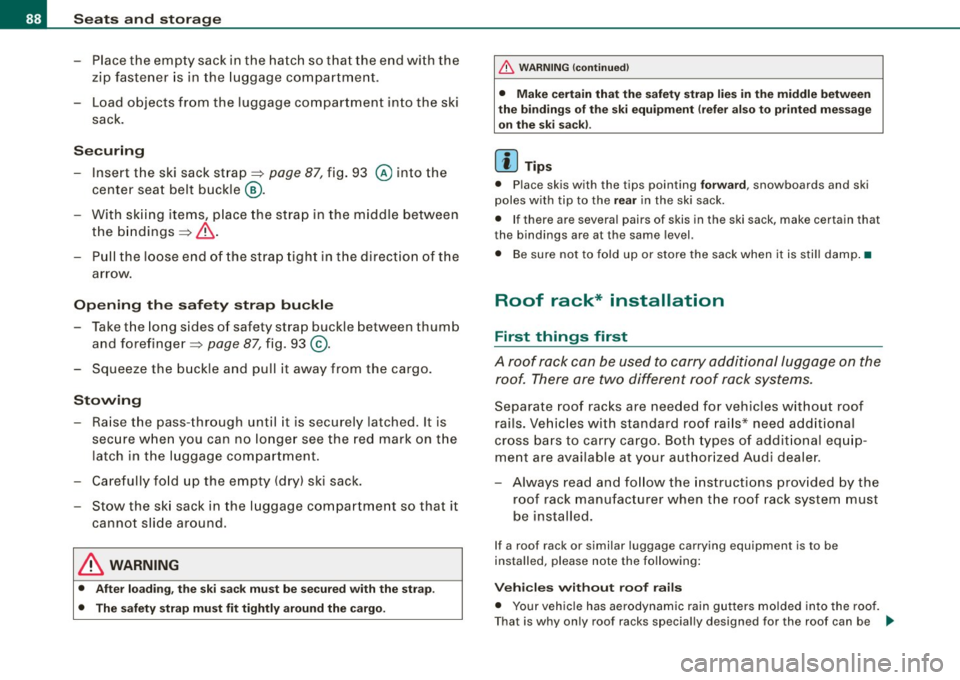
Seats and storage
-Place the empty sack in the hatch so that the end with the
zip fastener is in the luggage compartment.
- Load objects from the luggage compartment into the ski
sack.
Securing
- Insert the ski sack strap ~ page 87, fig. 93 @ into the
center seat belt buckle
® ·
- With skiing items, place the strap in the middle between
the bindings ~& .
- Pull the loose end of the strap tight in the direction of the
arrow.
Opening the safety strap buckle
- Take the long sides of safety strap buckle between thumb
and forefinger ~
page 87, fig. 93 @.
- Squeeze the buckle and pull it away from the cargo.
Stowing
- Raise the pass-through until it is securely latched. It is
secure when you can no longer see the red mark on the
latch in the luggage compartment.
- Carefully fold up the empty (dry) ski sack.
- Stow the ski sack in the luggage compartment so that it
cannot slide around.
& WARNING
• After loading, the ski sack must be secured with the strap .
• The safety strap must fit tightly around the cargo.
& WARNING (continued)
• Make certain that the safety strap lies in the middle between
the bindings of the ski equipment (refer also to printed message on the ski sack).
[ i] Tips
• Place skis with the tips pointing forward, snowboards and ski
poles with tip to the
rear in the ski sack.
• If there are several pairs of skis in the ski sack, make certain that
the bindings are at the same level.
• Be sure not to fold up or store the sack when it is still damp. •
Roof rack* installation
First things first
A roof rack can be used to carry additional luggage on the
roof. There are two different roof rack systems.
Separate roof racks are needed for vehicles without roof
rails. Vehicles with standard roof rails* need additional
cross bars to carry cargo. Both types of additional equip
ment are available at your authorized Audi dealer.
- Always read and follow the instructions provided by the
roof rack manufacturer when the roof rack system must
be installed.
If a roof rack or similar luggage carrying equipment is to be
installed, please note the following:
Vehicles without roof rails
• Your vehicle has aerodynamic rain gutters molded into the roof.
That is why only roof racks specially designed for the roof can be .,,
Page 91 of 324
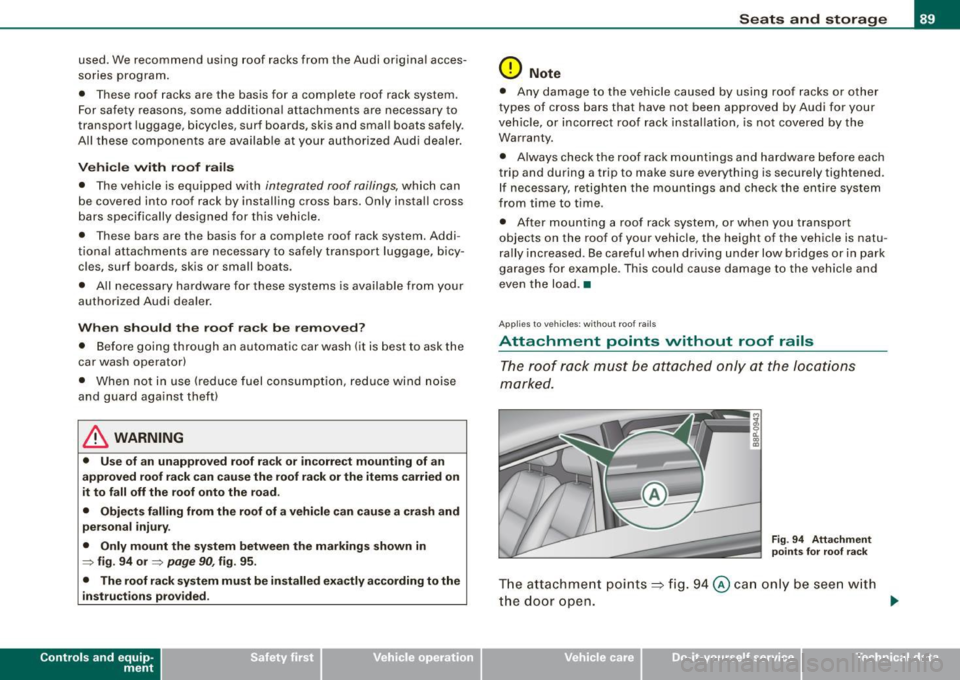
used. We recommend using roof racks from the Audi original acces
sories program.
• Th ese roof racks are the basis for a complete roof rack system .
For safety reasons, some additional attachments are necessary to
transport luggage, bicycles, surf boards, skis and small boats safely .
All these components are available at your authorized Audi dealer.
Vehicle with roof rails
• The vehicle is equipped with integrated roof railings, which can
be covered into roof rack by installing cross bars. Only install cross
bars specifically designed for this vehicle.
• Th ese bars are the basis for a complete roof rack system. Addi
tional attachments are necessary to safely transport luggage, bicy
cles, surf boards, skis or small boats.
• All necessary hardware for these systems is available from your
authorized Audi dealer.
When should the roof rack be removed?
• Before going through an automatic car wash (it is best to ask the
car wash operator)
• When not in use (reduce fuel consumption, reduce wind noise
and guard against theft)
& WARNING
• Use of an unapproved roof rack or incorrect mounting of an
approved roof rack can cause the roof rack or the items carried on
it to fall off the roof onto the road.
• Objects falling from the roof of a vehicle can cause a crash and
personal injury.
• Only mount the system between the markings shown in
~ fig. 94 or ~ page 90, fig. 95.
• The roof rack system must be installed exactly according to the
instructions provided .
Contro ls and eq uip
ment
Seats and storage
0 Note
• Any damage to the vehicle caused by using roof racks or other
types of cross bars that have not been approved by Audi for your
vehicle, or incorrect roof rack installation, is not covered by the
Warranty.
• Always check the roof rack mountings and hardware before each
trip and during a trip to make sure everything is securely tightened.
If necessary, retighten the mountings and check the entire system
from time to time.
• After mounting a roof rack system, or when you transport
objects on the roof of your vehicle, the height of the vehicle is natu
rally increased . Be careful when driving under low bridges or in park
garages for example . This could cause damage to the vehicle and
even the
load. a
Applies to veh icles: without roof rails
Attachment points without roof rails
The roof rack must be attached only at the locations
marked.
Fig . 94 Attachment
points for roof rack
The attachment points=> fig. 94 @can only be seen with
the door open. .,
Vehicle care I I irechnical data
Page 92 of 324
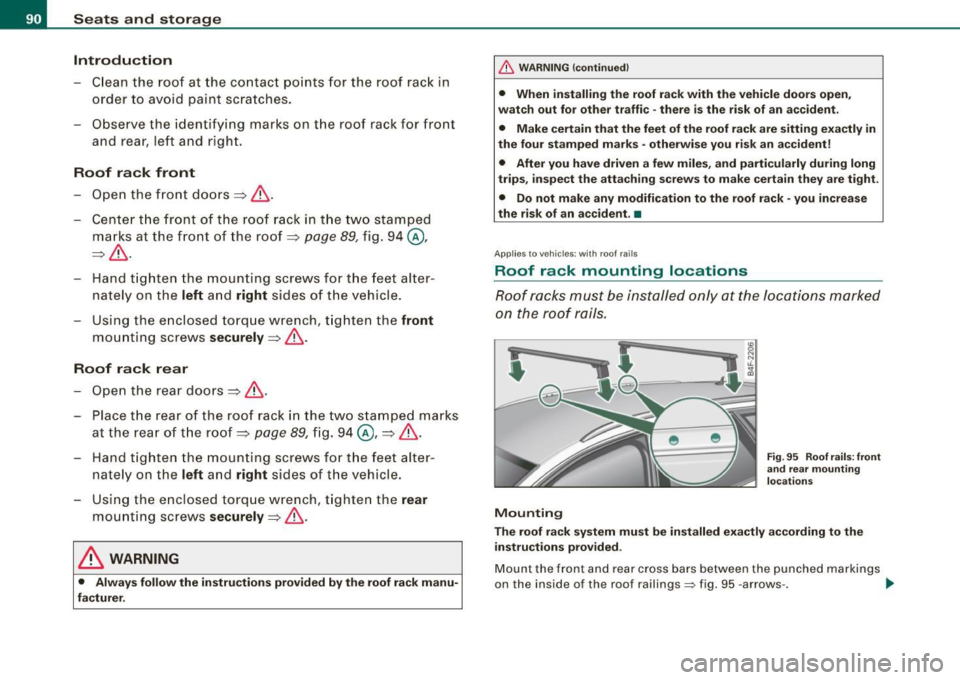
Seats and storage
Introduction
- Clean the roof at the contact points for the roof rack in
order to avoid paint scratches.
- Observe the ident ifying marks on the roof rack for front
and rear, left and right.
Roof rack front
- Open the front doors => & .
- Center the front of the roof rack in the two stamped
marks at the front of the roof=>
page 89, fig. 94 @,
=> & .
Hand tighten the mounting screws for the feet alter
nately on the left and right sides of the vehicle.
- Using the enclosed torque wrench, tighten the front
mounting screws securely=>& .
Roof rack rear Open the rear doors=>& .
Place the rear of the roof rack in the two stamped marks
at the rear of the roof=>
page 89, fig. 94 @, => & .
- Hand tighten the mounting screws for the feet alter
nately on the left and right sides of the vehicle.
- Using the enclosed torque wrench, tighten the rear
mounting screws securely=>& .
& WARNING
• Always follow the instructions provided by the roof rack manu
facturer.
& WARNING (continued)
• When installing the roof rack with the vehicle doors open,
watch out for other traffic -there is the risk of an accident.
• Make certain that the feet of the roof rack are sitting exactly in
the four stamped marks -otherwise you risk an accident!
• After you have driven a few miles, and particularly during long
trips, inspect the attaching screws to make certain they are tight.
• Do not make any modification to the roof rack -you increase
the risk of an accident. •
App lies to vehi cles : w it h roof rails
Roof rack mounting locations
Roof racks must be installed only at the locations marked
on the roof rails.
Mounting
Fig. 95 Roof rails: front
and rear mounting
locations
The roof rack system must be installed exactly according to the
instructions provided.
Mount the front and rear cross bars between the punched markings
on the inside of the roof railings=> fig. 95 -arrows- .
~
Page 93 of 324
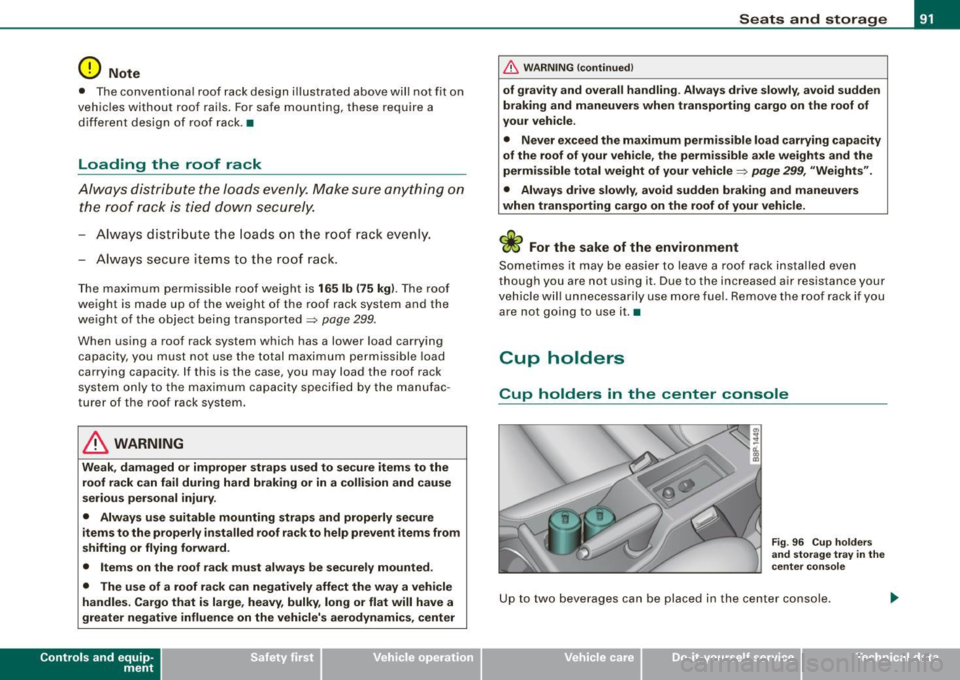
0 Note
• The conventiona l roof rack design illustrated above will not fit on
vehic les without roof rai ls . For safe mounting, these require a
different design of roof rack .•
Loading the roof rack
Al ways di stri bute the loads evenly . M ake sure any thing on
the roof r ack is tied dow n se cu rely.
- A lways distr ibute the loa ds on the r oof rack evenly .
- Alw ays secure items to t he roo f rack.
The maximu m permissi ble roof weight is 165 lb (75 kg ). The roof
weight is made up of the weight of the roof rack system and the
weight of the object bei ng transported =>
page 299.
When using a roof rack system which has a lower load carrying
capacity, you must not use the t otal maximum permis sible load
carrying capacity . If this is the case, you may load the roof rack
system on ly to the maximum capac ity specifie d by the manufac
turer of the roof rack system.
& WARNING
Weak , damaged or improper straps used to secu re items to the
roof rack can fail durin g hard braking or in a collision and cause
s erio us personal injury .
• Alway s use suitable mounting strap s and properly secure
item s to the properly in stalled roof rack to help pre vent items from
shifting or flying forward .
• Items on the roof rack must al ways be securely mounted .
• The u se of a roof ra ck can negatively affect the way a vehi cle
handles . Cargo that is large , heavy, bulky , long or flat will have a
greater negative influenc e on the vehicle 's aerodynamics, center
Con tro ls and eq uip
ment
Seats and storag e
& WARNING !continued )
of gravity and overall handling . Alwa ys drive slowly , avoid sudden
braking and maneuver s when tr ansporting cargo on the roof of
your vehicle .
• Nev er e xceed the ma ximum permi ssible load car rying capacity
of the roof of your v eh ic le, the permissible axle w eights and the
pe rmis sible tot al weight of your vehicle=>
page 299, "Weight s".
• Always drive s lo w ly, avoid sudden br aking and maneuvers
when tran sporting cargo on the roof of your vehicle .
~ For the sake of the environment
Sometimes it may be easier to leave a roof rack installed even
though you are not using it. Due to the increased air resistance your
ve hic le w ill unnecessarily use more fue l. Remove the roof rack i f yo u
are not going to use it .•
Cup holders
Cup holders in the center console
F ig . 96 Cup hol ders
an d s torag e tray in th e
ce nte r c ons ole
Up to two beverages can be placed in the center console .
Vehicle care I I irechnical data
Page 94 of 324
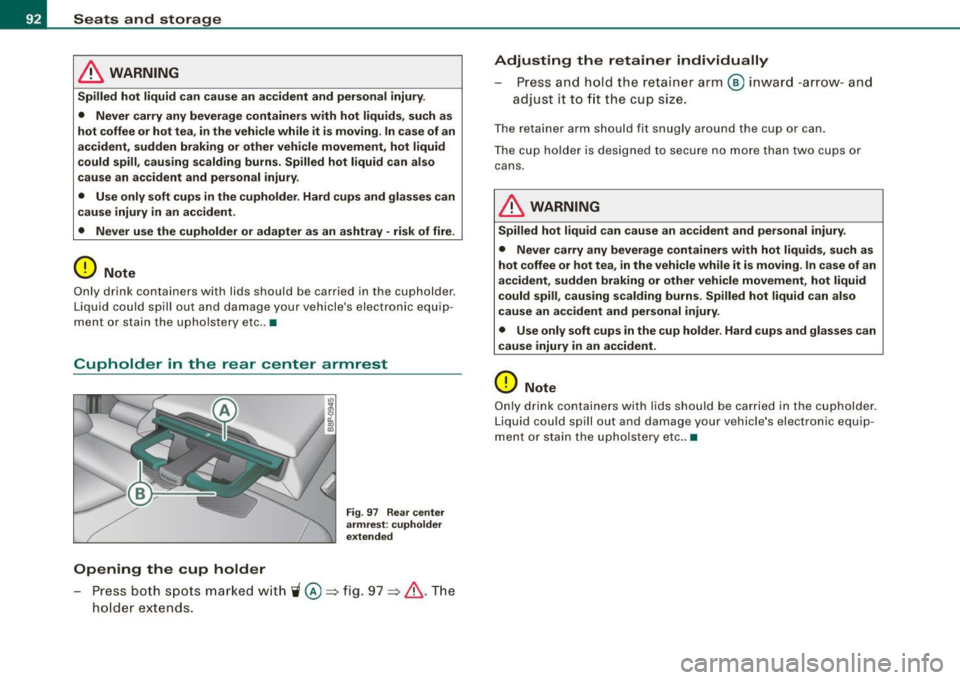
Seats and storage
& WARNING
Spilled hot liquid can cau se an a ccident and per sonal injury .
• Never carry any beverage conta iner s with hot liquid s, such as
hot coffee or hot tea , in the veh icle wh ile it is moving . In case of an
accident , sudden braking or other vehicle movement , hot liquid
could spill , causing scald ing burns . Spilled hot l iquid can also
c au se an accident and personal injury .
• Use only soft cups in the cupho lder . Hard cups and glasses can
c ause injury in an accident .
• Never use the cupholder or adapter as an ashtray -ris k of fire .
0 Note
Only drink containers with lids should be carried in the cupholder.
L iquid cou ld spi ll out and damage your vehicle's electronic equ ip
ment or stain the upholstery etc .. •
Cupholder in the rear center armrest
Opening the cup holder
Fig . 97 Rea r cent er
armre st : c upholder
extended
P ress bo th s pots mar ke d with ii @ ~ fig. 97 ~& .The
holde r exten ds.
Adjusting the retainer individually
Press and hold the reta iner a rm @ in wa rd -arrow- an d
adjust it to fit t he cup size.
T he retainer arm should f it snugly a round the cup or can.
T he cup holder is designed to secure no mo re than two cups o r
cans .
& WARNING
Spilled hot liquid can cause an accident and personal inju ry.
• Never carry any beverage containers with hot liquid s, such as
hot coffee or hot tea , in the vehicle while it is moving . In case of an
accident, sudden braking or other vehicle movement , hot l iquid
could spill , causing scalding burns . Spilled hot liquid can also
cause an accident and personal injury .
• Use on ly soft cups in the cup holder. Hard cups and glas ses can
cause injury in an accident .
0 Note
Only d rink co ntainers with lids sho uld be ca rried in th e cupholde r.
L iquid could spill out and damage your vehicle's electronic equip
m ent or s tai n t he uphols tery e tc . . •
Page 109 of 324
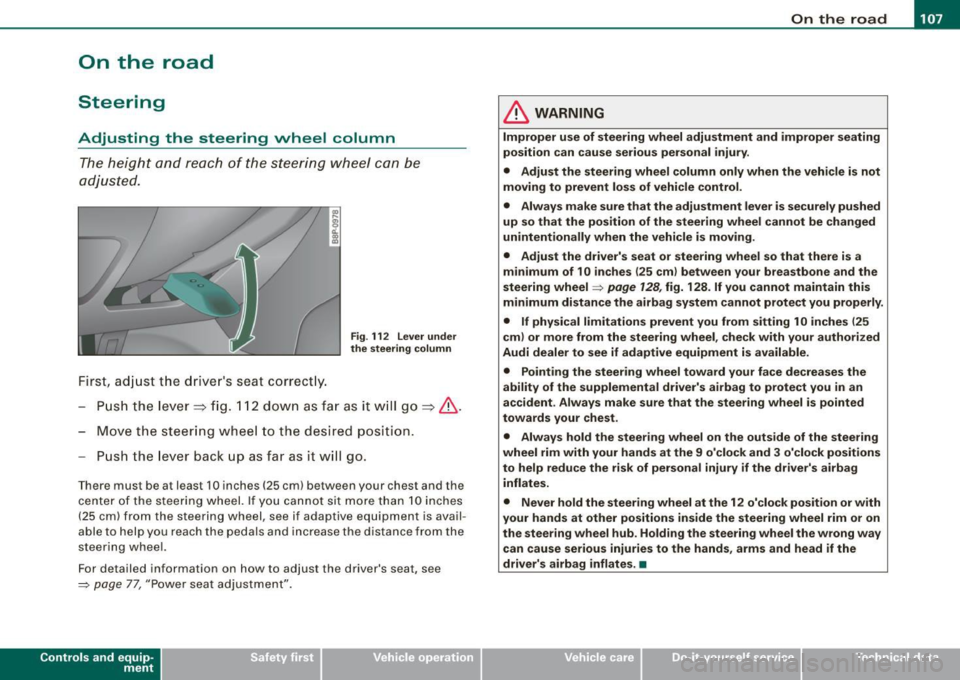
___________________________________________________ O_ n_ t_h _e_ r_o _a_ d _ ___._
On the road
Steering
Adjusting the steering wheel column
The heigh t an d reac h of th e ste er ing wheel can b e
adjusted .
Fir st, adju st the dr iver 's se at corre ctly.
Fig . 112 Lever under
the steering column
- Push t he leve r~ fig. 112 down as far as it will go~& .
- Move the steering w heel to the desi red po sitio n.
Pu sh t he lever back up as f ar as it will g o.
The re m ust be at least 1 0 inches ( 25 cm) between your chest and the
c e nt er of t he stee ring wh eel. If you c ann ot si t mo re than 1 0 inche s
( 25 cm) from the stee rin g w hee l, see if adaptiv e equi pment is ava il
abl e to h elp you r each th e peda ls a nd incr ease the distanc e from th e
st eerin g whe el.
Fo r deta ile d informat ion o n how to a djust the drive r's seat, see
=> p age 77 , "Po wer seat ad ju stm ent".
Con tro ls and eq uip
ment
& WARNING
Improper use of steering wheel adjustment and improper seating
position can cause serious personal injury .
• Adjust the steering wheel column only when the vehicle is not
moving to prevent loss of vehicle control .
• Always make sure that the adjustment lever is securely pushed
up so that the position of the steering wheel cannot be changed
unintentionally when the vehicle is moving .
• Adjust the driver's seat or steering wheel so that there is a
minimum of 10 inches {25 cm ) between your breastbone and the
steering wheel=>
page 128 , fig. 128. If you cannot maintain this
minimum distance the airbag system cannot protect you properly.
• If physical limitations prevent you from sitting 10 inches (25
cm) or more from the steering wheel, check with your authorized
Audi dealer to see if adaptive equipment is available.
• Pointing the steering wheel toward your face decreases the
ability of the supplemental driver's airbag to protect you
in an
accident . Always make sure that the steering wheel is pointed
towards your chest.
• Always hold the steering wheel on the outside of the steering
wheel rim with your hands at the 9 o'clock and 3 o'clock positions
to help reduce the risk of personal injury if the driver's airbag
inflates.
• Never hold the steering wheel at the 12 o'clock position or with
your hands at other positions inside the steering wheel rim or on
the steering wheel hub. Holding the steering wheel the wrong way
can cause serious injuries to the hands, arms and head if the
driver's airbag inflates. •
Vehicle care
I I irechnical data
Page 129 of 324

________________________________________________ D_r_iv _ i _n_ g~ S_ a_ fe_ ly __ !II
Important things to do before driving
Safety is everybody's job! Vehicle and occupant safety
always depends on the informed and careful driver.
For your safety and the safety of your passengers, before
driving always:
-Make sure that all lights and signals are operat ing
correctly.
- Make sure that the tire pressure is correct.
- Make sure that all windows are clean and afford good
visibility to the outside.
- Secure all luggage and other items carefully =>
page 94.
-Make sure that noth ing can interfere w ith the pedals.
- Adjust front seat, head restraint and mirrors correctly for your height .
- Instruct passengers to adjust the head restraints
according to their height.
- Make sure to use the right ch ild restraint correctly to
protect children =>
page 169, "Child Safety ".
- Sit properly in your seat and make sure that your passen
gers do the same=>
page 74, "General recommenda
tions".
- Fasten your safety belt and wear it p roperly. Also instruct
your passengers to fasten the ir safety belts properly
=>
page 137. •
Controls and equip
ment Safety first
Vehicle operation
What impairs driving safety?
Safe driving is directly related to the condition of the
vehicle, the driver as well as the driver's ability to concen
trate on the road without being distracted.
The driver is responsible for the safety of the vehicle and all
of its occupants. If your ability to drive is impaired, safety
risks for everybody in the vehicle increase and you also
become a hazard to everyone else on the road =>& .There
fore:
Do not let yourself be distracted by passengers or by
using a cellular telephone .
NEVER drive when your driving ability is impaired (by
medications, alcohol, drugs, etc.).
- Observe all traffic laws, rules of the road and speed limits
and plain common sense .
- ALWAYS adjust your speed to road, traffic and weather
conditions.
- Take frequent breaks on long trips. Do not drive for more
than two hours at a stretch.
- Do NOT drive when you are tired, under pressure or when
you are stressed .
& WARNING
Impaired driving safety increases the risk of serious personal
injury and death whenever a vehicle is being used. •
Vehicle care Do-it-yourself service Technical data
Page 132 of 324

........ _o_ r_iv _i_ n""' g::;._ S_ a_f _e _ly =---------------------------------------------------
& WARNING (continued)
• Always make sure that there are at least 10 inches (25 cm)
between the front passenger's breastbone and the instrument
panel.
• Each passenger must always sit on a seat of their own and
properly fasten and wear the safety belt belonging to that seat.
• Before driving, always adjust the front passenger seat and
head restraint properly.
• Always keep your feet on the floor in front of the seat . Never
rest them on the seat, instrument panel, out of the window, etc.
The airbag system and safety belt will not be able to protect you
properly and can even increase the risk of injury in a crash.
• Never drive with the backrest reclined or tilted far back! The
farther the backrests are tilted back, the greater the risk of injury due to incorrect positioning of the safety belt and improper
seating position.
• Children must always ride in child safety seats~
page 169.
Special precautions apply when installing a child safety seat on
the front passenger seat~
page 147. •
Proper seating positions for passengers in
rear seats
Rear seat passengers must sit upright with both feet on
the floor consistent with their physical size and be prop
erly restrained whenever the vehicle is in use.
To reduce the risk of injury caused by an incorrect seating
position in the event of a sudden braking maneuver or an
accident, your passengers on the rear bench seat must
always observe the following:
- Make sure that the seatback is securely latched in the
upright position =>
page 83.
-Adjust the head restraint so that the upper edge is as
even with the top of your head as possible but no lower
than eye level=>
page 131.
-Keep both feet flat in the footwell in front of the rear seat .
- Fasten and wear safety belts properly=>
page 141.
-Make sure that children are always properly restrained in
a child restraint that is appropriate for their size and age
=>
page 169.
& WARNING
Passengers who are improperly seated on the rear seat can be
seriously injured in a crash.
• Each passenger must always sit on a seat of their own and
properly fasten and wear the safety belt belonging to that seat.
• Safety belts only offer maximum protection when the seatback
is securely latched in the upright position and the safety belts are
properly positioned on the body. By not sitting upright, a rear seat
passenger increases the risk of personal injury from improperly
positioned safety belts!
• Always adjust the head restraint properly so that it can give
maximum protection. •
Page 134 of 324

-L..___.:D=-:.. r.:....iv .:....i:..:. n..:.: g;a...: S=-= a:..:.f -=e :..:..IY !,__ ________________________________________________ _
examples will make you more aware of seating positions that are
dangerous.
Therefore, whenever the vehicle is moving:
• never stand up in the vehicle
• never stand on the seats
• never kneel on the seats
• never ride with the seatback reclined
• never lie down on the rear seat
• never lean up against the instrument panel
• never sit on the edge of the seat
• never sit sideways
• never lean out the window
• never put your feet out the window
• never put your feet on the instrument panel
• never rest your feet on the seat cushion or back of the seat
• never ride in the footwell
• never ride in the cargo area
& WARNING
Improper seating positions increase the risk of serious personal
injury and death whenever a vehicle is being used.
• Always make sure that all vehicle occupants stay in a proper
seating position and are properly restrained whenever the vehicle
is being used. •
Pedal area
Pedals
The pedals must always be free to move and must never
be interfered with by a floor mat or any other object.
Make sure that all pedals move freely without interference and that
nothing prevents them from returning to their original positions.
Only use floor mats that leave the pedal area free and can be
secured with floor mat fasteners.
If a brake circuit fails, increased brake pedal travel is required to
bring the vehicle to a full stop.
& WARNING
Pedals that cannot move freely can cause loss of vehicle control
and increase the risk of serious injury.
• Never place any objects in the driver's footwell. An object could
get into the pedal area and interfere with pedal function. In case
of sudden braking or an accident, you would not be able to brake
or accelerate!
• Always make sure that nothing can fall or move into the
driver's footwell. •
Floor mats on the dr iver side
Always use floor mats that can be securely attached to
the floor mat fasteners and do not interfere with the free
movement of the pedals.
-Make sure that the floor mats are properly secured and
cannot move and interfere with the pedals~
&- .,
Page 135 of 324
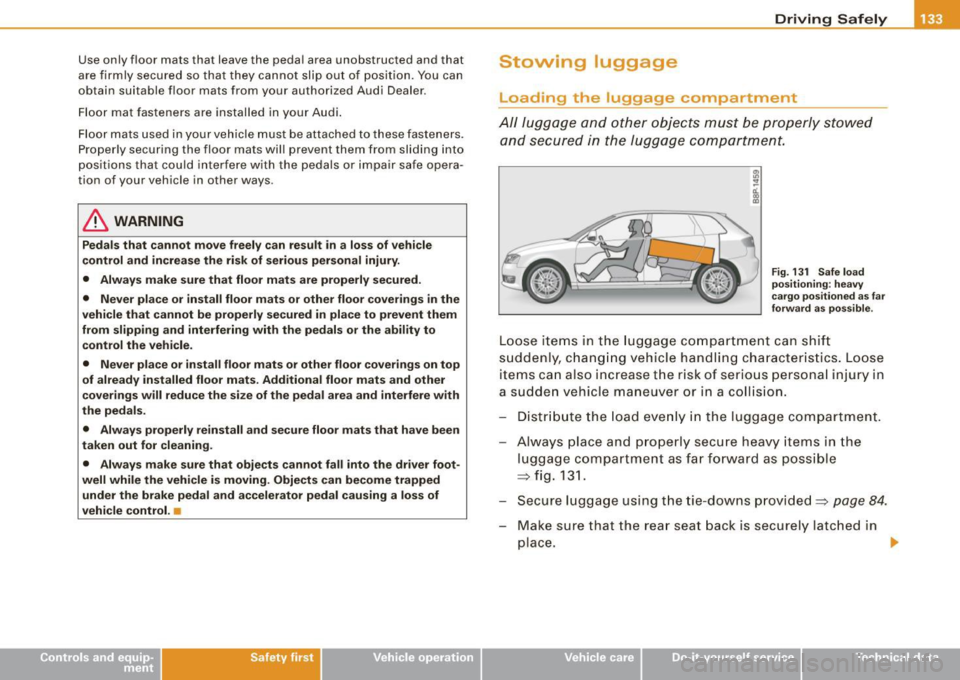
Use only floor mats that leave the pedal area unobstructed and that
are firmly secured so that they cannot slip out of position. You can
obtain suitable floor mats from your authorized Audi Dealer .
Floor mat fasteners are installed in your Audi.
Floor mats used in your vehicle must be attached to these fasteners .
Properly securing the floor mats will prevent them from sliding into
positions that could interfere with the pedals or impair safe opera
tion of your vehicle in other ways .
& WARNING
Pedals that cannot move freely can result in a loss of vehicle
control and increase the risk of serious personal injury.
• Always make sure that floor mats are properly secured.
• Never place or install floor mats or other floor coverings in the
vehicle that cannot be properly secured in place to prevent them
from slipping and interfering with the pedals or the ability to
control the vehicle .
• Never place or install floor mats or other floor coverings on top
of already installed floor mats. Additional floor mats and other
coverings will reduce the size of the pedal area and interfere with
the pedals.
• Always properly reinstall and secure floor mats that have been
taken out for cleaning.
• Always make sure that objects cannot fall into the driver foot·
well while the vehicle is moving. Objects can become trapped
under the brake pedal and accelerator pedal causing a loss of
vehicle control. •
Safety first
Driving Safely
Stowing luggage
Loading the luggage compartment
All luggage and other objects must be properly stowed
and secured in the luggage compartment.
Fig. 131 Safe load
positioning: heavy
cargo positioned as far
forward as possible.
Loose items in the luggage compartment can shift
suddenly, changing vehicle handling characteristics. Loose
items can also increase the risk of serious personal injury in
a sudden vehicle maneuver or in a collision.
Distribute the load evenly in the luggage compartment.
Always place and properly secure heavy items in the
luggage compartment as far forward as possible
=> fig. 131.
Secure luggage using the tie-downs provided=> page 84.
Make sure that the rear seat back is securely latched in
place.
1iJ,,
Vehicle care I I irechnical data